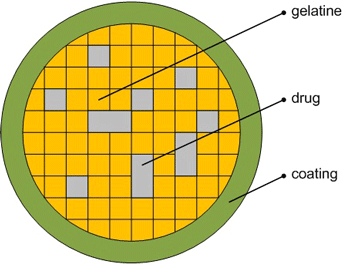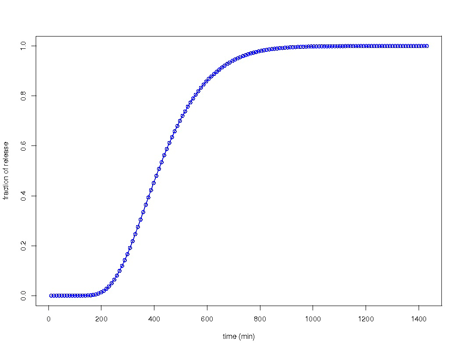by Marija Bezbradica, Martin Crane and Heather J. Ruskin
The project at Dublin City University aims to establish new computational models for drug dissolution systems, specifically for sustained release drugs used in the gastro-intestinal tract. It seeks to improve existing algorithms and develop improved ones to predict the release curves of active substances. High-performance computing and cellular automata are used to investigate probabilistic drug dissolution phenomena. The project is an ongoing collaboration with industrial partner, Sigmoid Pharma Ltd.
Pharmaceutical companies today face a growing demand for more complex drug design for targeted dose delivery. Targeted drug delivery systems (DDS) have the primary objective of achieving drug release at a sustained rate at the targeted site. Modern drug design processes require collaboration between pharmacists, bioengineers and computer scientists. Thus, the computational modelling of DDS is a constantly developing field with the potential to become an integral part of pharmaceutical research. In silico modelling addresses the main problems of drug development through (1) reducing experimental cost, (implicit in large amount of in vitro testing), (2) accelerating time for drug progression to market, (3) better understanding of drug transport processes and (4) converting the existing approach from a descriptive to a predictive one.
The researchers within the Centre for Scientific Computing and Complex Systems Modelling, (Sci-Sym), at Dublin City University are using high performance computing to develop computational and mathematical models for complex systems in multi-disciplinary areas, including engineering and the natural and applied sciences. Drug dissolution modelling, an ongoing project building on work by Dr Ana Barat and Dr Niall McMahon has involved both probabilistic and deterministic models and numerical simulation. Current work is expanding on these efforts by investigating the importance of various microscopic effects to system evolution over time. This research is funded by the Irish Research Council for Science, Engineering and Technology and is an ongoing collaboration with Sigmoid Pharma Ltd.

Figure 1: Design of modelled drug.

Figure 2: Typical release curve (sigmoidal shape) - No release within first two hours and initial burst effect due to environment transition after two hours.
The project aims at simulation of coated drugs for targeted delivery and addresses the difficulty of understanding how the molecular-level interactions between coating and environment affect characteristic behaviour. Controlled, targeted, release is achieved by using polymers with different dissolution characteristics, making polymer dissolution one of the most important phenomena to be modelled. The model validation is performed against in vitro pharmaceutical data for a drug targeting the gastro-intestinal (GI) tract, with ethylcellulose as the polymer coating of the microspherical drug particle geometry. The novelty in this work is the effort to mimic non-homogeneous dispersion of the drug which improves the realism of the model for this complex system.
The first step in modelling the dissolution is to determine the in vitro dissolution rate under various external conditions, which mimic metabolic processes. Common USP II apparatuses are used for collecting experimental data provided by colleagues at Sigmoid Pharma Ltd. The model results are evaluated against these experimental data.
Applying a bottom-up approach to observe the probabilistic behaviour of individual particles in the system has an advantage over the top-down approach, as it has the potential to yield better predictions while requiring less initial information. Monte Carlo is used as a framework for the cellular automata modelling. The system is represented as a matrix of agents where each agent has defined rules of behaviour and transitions. Microscopic features of the model can be investigated through transitions between agent states. A dimensional analysis approach is used to fine tune model precision. Using high performance computing facilities, provided by the Irish Centre for High-End Computing (ICHEC), we are parallelising the model for large-scale short simulation times. Parallelisation is implemented using OpenMP. Algorithms are coded using the C++ language and OpenGL libraries for graphic representation where the latter is useful, in particular, for the development and liaison stage.
Preliminary results, which include erosion as a main transport mechanism, give a qualitative match to characteristic release profiles with typical “biphasic” release. A future focus is incorporation, into the model, of additional phenomena, caused by additives to the coating structure. Furthermore, model augmentation will include the effect of different polymer coatings and different media surrounding the drug, in order to simulate different stages of the GI tract environment. The deduction of unknown parameters from the experimental release curves, using reverse engineering and inverse Monte Carlo methods, is a long-term aim. Nevertheless, the approach to date has enabled comparison of a set of simulated and experimental release curves, allowing us to determine key parameters for this novel formulation and to reproduce qualitative behaviour.
Acknowledgements
Authors would like to acknowledge the financial support from the Irish Research Council for Science, Engineering and Technology (IRCSET), under the Enterprise Partnership Scheme, grant number P07669 and access to ICHEC (Irish Centre for High-End Computing) facilities.
Links:
http://sci-sym.dcu.ie/
http://www.computing.dcu.ie/~msc/
http://sigmoidpharma.com/dynamicdata/default.asp
Please contact:
Marija Bezbradica
Dublin City University, Ireland
Tel: +353 1 700 6747
E-mail:










